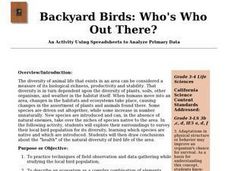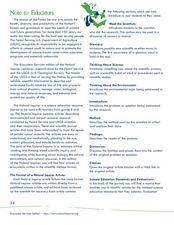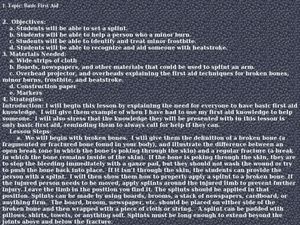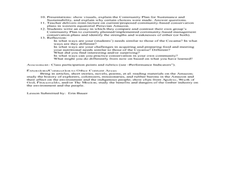Curated OER
Life Science: Heavy Weight
Students investigate adolescent obesity and its health impact. In this health and obesity lesson, students research the problem, develop a survey regarding eating habits, then analyze the nutritional information on commonly eaten foods...
Curated OER
Gastrointestinal Illness Strikes
In this epidemiology worksheet, students read a scenario about people reporting an acute episode of gastrointestinal illness. Students determine if its an outbreak and then complete 4 short answer questions.
Curated OER
UV: Use Caution
Students investigate the concept of skin cancer and its relation to using tanning beds that expose people to artificial ultraviolet rays. They research the effects and look for ways to prevent the onset of skin cancer from the...
Curated OER
Mayor Puts City on Diet to Lose a Million Pounds
Students read a story called Mayor Puts City on Diet to Lose a Million Pounds and answer vocabulary and comprehension questions about it. In this current event Lose a Million Pounds lesson plan, students respond to literature by...
Curated OER
That's Entertainment
Second graders view examples of active lifestyles in works of Robert Harris, and list and graph their daily activities to see if they lead active lifestyles. Students then name forms of entertainment that require practice,...
Curated OER
How Many Animals?
Learners use their math skills to develop estimates for the population of several animal species native to the Austrailian rainforest. It is a simulation that researchers at the Center for Rainforest Studies in Australia perform to...
Curated OER
Quality of life for kids
Students explore the meaning of quality of life. Also, the need to prioritize means that government spending decisions are political, with winners and losers. Discussion platforms are on the six dimensions to a child's well-being:...
Curated OER
World Toilet Day
In this World Toilet Day worksheet, students complete activities such as reading a passage, matching phrases, fill in the blanks, choose the correct word, multiple choice, unscramble the words, sequencing, unscramble the sentences,...
Curated OER
The Numbers Tell the Story
Students demonstrate how to gather and interpret statistical data. In this data analysis lesson, students search for statistics on the health effects of smoking and place the information into charts. Students create these charts online...
Curated OER
The Tobacco Time Bomb: What's In A Cigarette?
In this enlightening and disturbing health lesson, students read and discuss information on smoking and closely-look at the ingredients in a cigarette. You will be amazed at the list of ingredients that are found in cigarettes. This...
Curated OER
Ins and Outs of Respiration
Students determine their respiratory rate and explore the factors that affect breathing rate.
Curated OER
How Machines Help Us Stay Healthy
Students visit different departments at a local hospital to see how machines help peoples such as the CAT scan machine. They build a model of such a machine that shows how patients are moved in and out of the machine.
Curated OER
Wildcat Dumping
Students design and print an educative pamphlet addressing Wildcat Dumping in their community by conducting research. They conduct a survey by investigating local occurrences of Wildcat Dumping and collecting data to share with the...
Curated OER
Backyard Birds: Who's Who Out There?
Students practice techniques of field observation and data-gathering while studying local bird population, describe ecosystem as complex combination of elements, which can affect or be affected by each other, and determine effects of...
Curated OER
Beginning Graphs in MS Excel
Students practice creating graphs in Microsoft Excel. In this technology lesson, students conduct a random survey and collect data. Students use the Microsoft Excel program to create a bar graph of the data.
Curated OER
Natural Inquirer Ecosystem Article Lesson
Students discover new ways to preserve the ecosystem by completing graphic organizers. In this environmental lesson, students read an article from the Natural Inquirer in small groups and fill out a graphic organizer based on the...
Curated OER
Recognizing a Message's Point of View
Pupils study the physical, mental, and social health benefits of regular exercise while attempting to recognize the point of view of media messages. They read an article and discern ways in which they can make regular exercise a part of...
Curated OER
Data Collection
Learners investigate qualitative and quantitative data. In this statistics lesson, students gather data on heights and weights of people and graph the distribution. Learners discuss the differences between qualitative and quantitative data.
Curated OER
Basic First Aid
Learners listen to basic first aid information. In this first aid lesson plan, students discuss CPR, Choking, Severe Bleeding, and Shock. They research the steps and how they can help in an emergency situation.
Curated OER
Evolution and Antibiotic Resistance
Pupils investigate the increasing problem of antibiotic resistance in such menacing diseases as tuberculosis and influenza. They take on the role of staff at a public health agency who are trying to communicate the problem to the public.
Curated OER
Being an Educated Consumer of Statistics
Students examine kinds of data used to report statistics, and create their own statistical report based on any of the four sources of media information (Internet, newspaper, TV, magazine).
Curated OER
What Do People Know About Radon?
Learners read the fictitious newspaper article entitled, "Levels of Radon in Jersey Town Exceed Limits." This helps them get a basic vocabulary started for the terms and concepts related to radon. In groups, they identify words that they...
Curated OER
Supermarkets, Sustenance and Sustainability
Students investigate jungles and the people who depend upon them. In this sustainability lesson, students research wild life conservation and discover the importance of a jungle to Amazonian people. Students create a group presentation...
Curated OER
Let's Read! Growing Vegetable Soup
Students state that vegetables come from plants. They identify a vegetable they can eat at home.

























